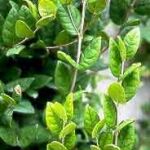| Common Name: |
Boldu |
| Other Names: |
Boldo, Boldus |
| Botanical Name: |
Peumus boldus |
| Genus: |
Peumus |
| Family: |
Monimiaceae |
| Native Location: |
Chile |
| Cultivation: |
Well-drained, sandy, acid soil in sun. |
| Propagation: |
By seed sown in spring; by semi-ripe cuttings in summer. |
| Harvest: |
Leaves are picked during the growing season and dried for infusions, liquid extracts, and tinctures. Alkaloids are extracted commercially from the bark. |
| Height: |
7m (22ft) |
| Width: |
5m (15ft) |
| Hardiness: |
Z9 |
| Parts Used: |
Leaves, Bark |
| Properties: |
A bitter, aromatic herb that improves the liver and gall bladder function, and expels worms. It is diuretic and a mild urinary antiseptic. |
| Medicinal Uses: |
Internally for liver disease, gallstones, urinary tract infections, intestinal parasites, and rheumatism. Formerly given as a substitute for quinine. Often added to weight-reduction formulas. Combines well with Berberis vulgaris (See, Barberry) and Chionanthus virginicanus (See, Fringe Tree) for liver and gall bladder complaints.
To treat gallstones, liver disease, gonorrhea; as a diuretic and sedative. |
| Typical Dose: |
A typical daily dose of boldo is approximately 60 to 200mg of dried leaves, taken as a tea. |
| Possible Side Effects: |
Boldo's side effects include skin irritation and convulsions. |
| Drug Interactions: |
| Taking boldo with these drugs may increase the risk of bleeding or bruising: |
| Abciximab, (ReoPro) |
Antithrombin III, (Thrombate III) |
Argatroban, (Argatroban) |
Aspirin, (Bufferin, Ecotrin) |
Aspirin and Dipyridamole, (Aggrenox) |
| Bivalrudin, (Angiomax) |
Clopidogrel, (Plavix) |
Dalteparin, (Fragmin) |
Danaparoid, (Orgaran) |
Dipyridamole, (Novo-Dipiridol, Persantine) |
| Enoxaparin, (Lovenox) |
Eptifibatide, (Integrillin) |
Fondaparinux, (Arixtra) |
Heparin, (Hepalean, Hep-Lock) |
Indobufen, (Ibustrin) |
| Lepirudin, (Refludan) |
Ticlopidine, (Alti-Ticlopidine, Ticlid) |
Tinzaparin, (Innohep) |
Tirofiban, (Aggrastat) |
Warfarin, (Coumadin, Jantoven) |
|
| Disease Effects: |
Boldo may worsen cases of gallstones, liver or kidney disease, and bile duct obstruction. |
| Culinary Uses: |
Aromatic leaves and bark are used locally for flavoring. |
| Warning: |
Contraindicated during pregnancy.
This herb is subject to legal restrictions in some countries. |
| Bibliography: |
The Encyclopedia of Herbs by Deni Brown Copyright ©1995, 2001 Dorling Kindersley Limited. pp 310-311
The Essential Herb-Drug-Vitamin Interaction Guide by Geo. T. Grossberg,MD and Barry Fox,PhD Copyright©2007 Barry Fox,PhD. Pp. 92-93 |

